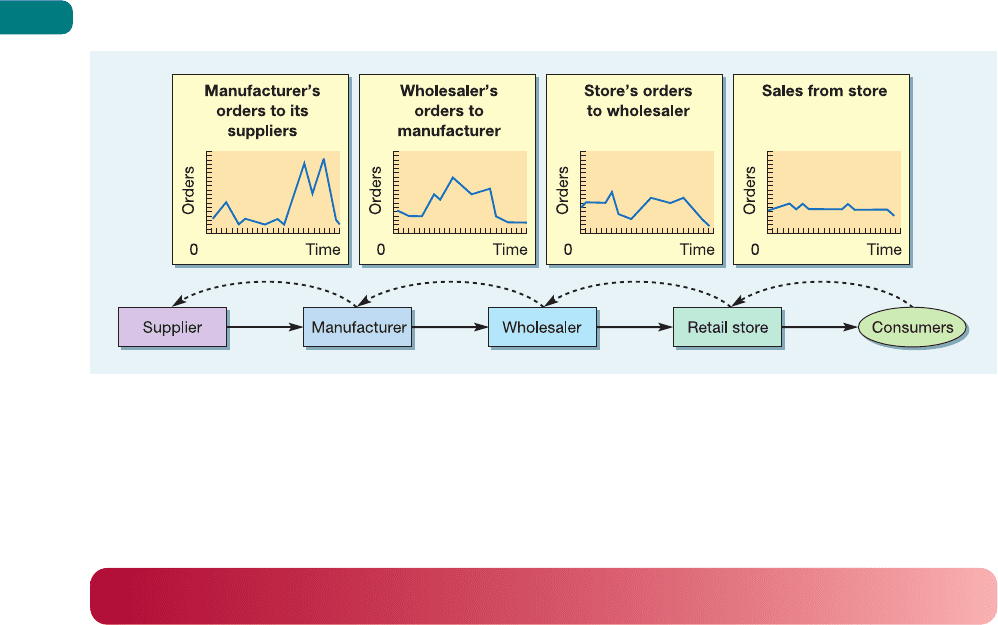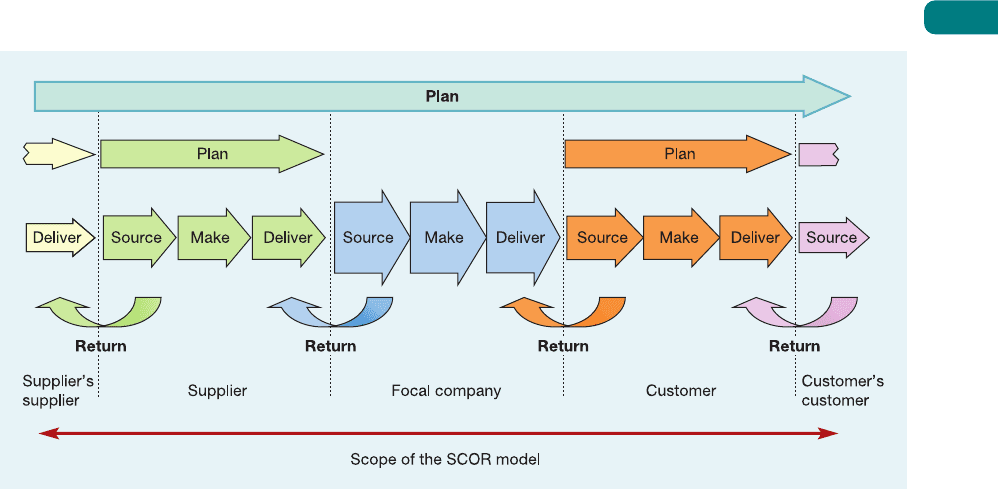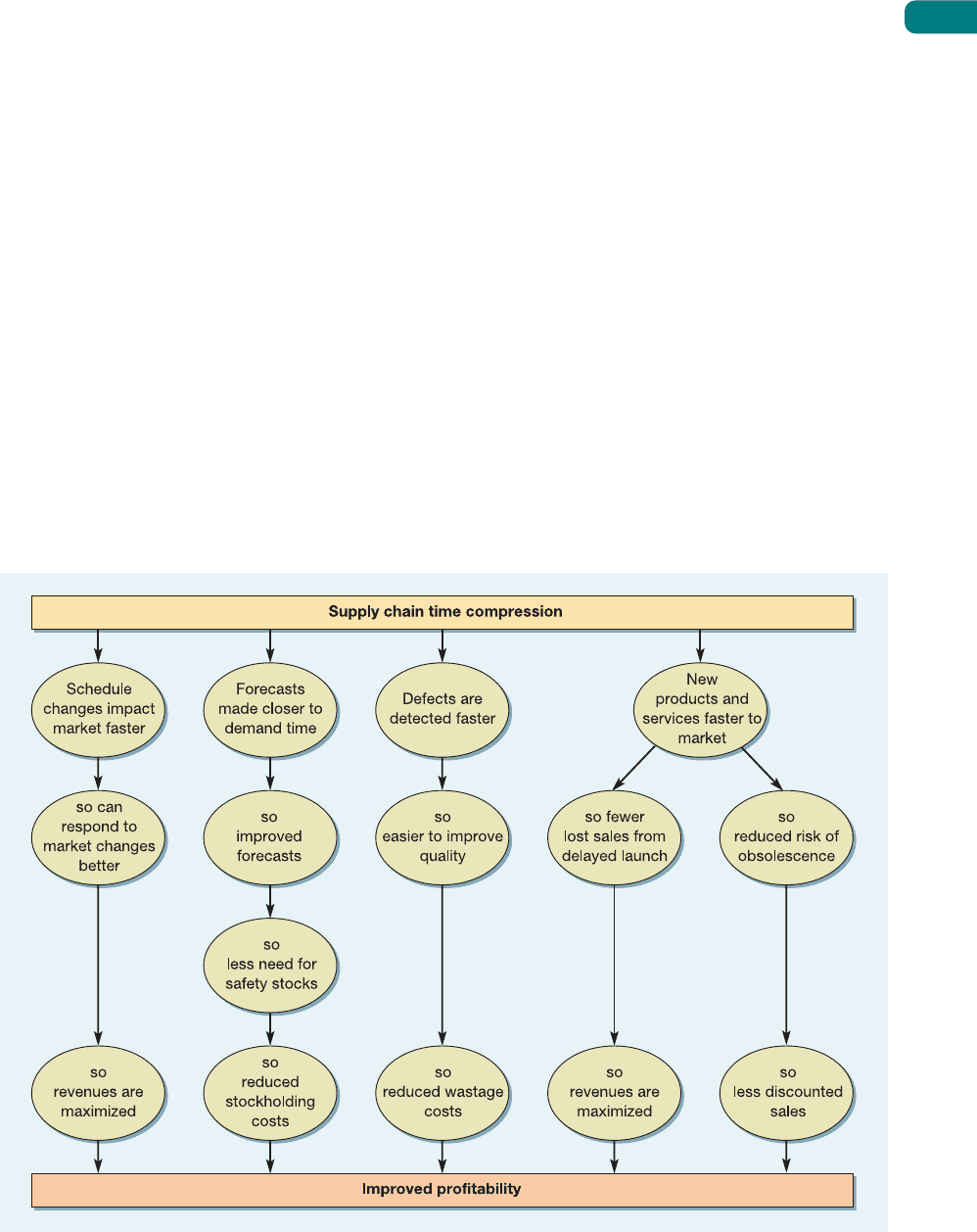Nigel S., Chambers S., Johnson R. Operations Management
Подождите немного. Документ загружается.


Part Three Planning and control
394
Figure 13.8 Typical supply chain dynamics
child says out loud what the message is, and the children are amused by the distortion of the
original message. Figure 13.8 shows the bullwhip effect in a typical supply chain, with relatively
small fluctuations in the market cause increasing volatility further back in the chain.
Supply chain improvement
Increasingly important in supply chain practice are attempts to improve supply chain per-
formance. These are usually attempts to understand the complexity of supply chain processes;
others focus on coordinating activities throughout the chain.
The SCOR model
The Supply Chain Operations Reference model (SCOR) is a broad, but highly structured and
systematic, framework to supply chain improvement that has been developed by the Supply
Chain Council (SCC), a global non-profit consortium. The framework uses a methodology,
diagnostic and benchmarking tools that are increasingly widely accepted for evaluating and
comparing supply chain activities and their performance. Just as important, the SCOR model
allows its users to improve, and communicate supply chain management practices within
and between all interested parties in their supply chain by using a standard language and
a set of structured definitions. The SCC also provides a benchmarking database by which
companies can compare their supply chain performance to others in their industries and
training classes. Companies that have used the model include BP, AstraZeneca, Shell, SAP
AG, Siemens AG and Bayer. The model uses three well-known individual techniques turned
into an integrated approach. These are:
● Business process modelling
● Benchmarking performance
● Best practice analysis.
Business process modelling
SCOR does not represent organizations or functions, but rather processes. Each basic ‘link’
in the supply chain is made up of five types of process, each process being a ‘supplier–
customer’ relationship, see Figure 13.9.
● ‘Source’ is the procurement, delivery, receipt and transfer of raw material items, sub-
assemblies, products and/or services.
M13_SLAC0460_06_SE_C13.QXD 10/20/09 9:45 Page 394

● ‘Make’ is the transformation process of adding value to products and services through
mixing production operations processes.
● ‘Deliver’ processes perform all customer-facing order management and fulfilment activities
including outbound logistics.
● ‘Plan’ processes manage each of these customer–supplier links and balance the activity of
the supply chain. They are the supply and demand reconciliation process, which includes
prioritization when needed.
● ‘Return’ processes look after the reverse logistics flow of moving material back from
end-customers upstream in the supply chain because of product defects or post-delivery
customer support.
All these processes are modelled at increasingly detailed levels from level 1 through to more
detailed process modelling at level 3.
Benchmarking performance
Performance metrics in the SCOR model are also structured by level, as is process analysis.
Level 1 metrics are the yardsticks by which an organization can measure how successful it
is in achieving its desired positioning within the competitive environment, as measured by
the performance of a particular supply chain. These level 1 metrics are the key performance
indicators (KPIs) of the chain and are created from lower-level diagnostic metrics (called
level 2 and level 3 metrics) which are calculated on the performance of lower-level processes.
Some metrics do not ‘roll up’ to level 1, these are intended to diagnose variations in perform-
ance against plan.
Best practice analysis
Best practice analysis follows the benchmarking activity that should have measured the
performance of the supply chain processes and identified the main performance gaps. Best
practice analysis identifies the activities that need to be performed to close the gaps. SCC
members have identified more than 400 ‘best practices’ derived from their experience. The
definition of a ‘best practice’ in the SCOR model is one that:
● Is current – neither untested (emerging) nor outdated.
● Is structured – it has clearly defined goals, scope and processes.
Chapter 13 Supply chain planning and control
395
Figure 13.9 Matching the operations resources in the supply chain with market requirements
M13_SLAC0460_06_SE_C13.QXD 10/20/09 9:45 Page 395

● Is proven – there has been some clearly demonstrated success.
● Is repeatable – it has been demonstrated to be effective in various contexts.
● Has an unambiguous method – the practice can be connected to business processes,
operations strategy, technology, supply relationships, and information or knowledge man-
agement systems.
● Has a positive impact on results – operations improvement can be linked to KPIs.
The SCOR roadmap
The SCOR model can be implemented by using a five-phase project ‘roadmap’. Within this
roadmap lies a collection of tools and techniques that both help to implement and support
the SCOR framework. In fact many of these tools are commonly used management decision
tools such as Pareto charts, cause–effect diagrams, maps of material flow and brainstorming.
Phase 1: Discover – Involves supply-chain definition and prioritization where a ‘Project
Charter’ sets the scope for the project. This identifies logic groupings of supply chains within
the scope of the project. The priorities, based on a weighted rating method, determine which
supply chains should be dealt with first. This phase also identifies the resources that are
required, identified and secured through business process owners or actors.
Phase 2: Analyse – Using data from benchmarking and competitive analysis, the appropriate
level of performance metrics are identified; that will define the strategic requirements of each
supply chain.
Phase 3: Material flow design – In this phase the project teams have their first go at creating a
common understanding of how processes can be developed. The current state of processes is
identified and an initial analysis attempts to see where there are opportunities for improvement.
Phase 4: Work and information flow design – The project teams collect and analyse the work
involved in all relevant processes (plan, source, make, deliver and return) and map the pro-
ductivity and yield of all transactions.
Phase 5: Implementation planning – This is the final and preparation phase for communicat-
ing the findings of the project. Its purpose is to transfer the knowledge of the SCOR team(s)
to individual implementation or deployment teams.
Benefits of the SCOR model
Claimed benefits from using the SCOR model include improved process understanding
and performance, improved supply chain performance, increased customer satisfaction and
retention, a decrease in required capital, better profitability and return on investment, and
increased productivity. And, although most of these results could arguably be expected when
any company starts focusing on business processes improvements, SCOR proponents argue
that using the model gives an above average and supply focused improvement.
Part Three Planning and control
396
Although the SCOR model is increasingly being adopted, it has been criticized for under-
emphasizing people issues. The SCOR model assumes, but does not explicitly address, the
human resource base skill set, notwithstanding the model’s heavy reliance on supply chain
knowledge to understand the model and methodology properly. Often external expertise
is needed to support the process. This, along with the nature of the SCC membership,
also implies that the SCOR model may be appropriate only for relatively large companies
that are more likely to have the necessary business capabilities to implement the model.
Many small to medium-sized companies may find difficulty in handle full-scale model
implementation. Some critics would also argue that the model lacks a link to the financial
plans of a company, making it very difficult to highlight the benefits obtainable, as well as
inhibiting senior management support.
Critical commentary
M13_SLAC0460_06_SE_C13.QXD 10/20/09 9:45 Page 396

The effects of e-business on supply chain management
practice
13
New information technology applications combined with internet-based e-business have
transformed supply chain management practice. Largely, this is because they provide better
and faster information to all stages in the supply chain. Information is the lifeblood of
supply chain management. Without appropriate information, supply chain managers cannot
make the decisions that coordinate activities and flows through the chain. Without appro-
priate information, each stage in the supply chain has relatively few cues to tell them what
is happening elsewhere in the chain. To some extent, they are ‘driving blind’ and having to
rely on the most obvious of mismatches between the activities of different stages in the chain
(such as excess inventory) to inform their decisions. Conversely, with accurate and ‘near
real-time’ information, the disparate elements in supply chains can integrate their efforts
to the benefit of the whole chain and, eventually, the end-customer. Just as importantly, the
collection, analysis and distribution of information using e-business technologies is far less
expensive to arrange than previous, less automated methods. Table 13.5 summarizes some of
the effects of e-business on three important aspects of supply chain management – business
and market information flow, product and service flow, and the cash flow that comes as a
result of product and service flow.
Information-sharing
One of the reasons for the fluctuations in output described in the example earlier was that
each operation in the chain reacted to the orders placed by its immediate customer. None of
the operations had an overview of what was happening throughout the chain. If information
had been available and shared throughout the chain, it is unlikely that such wild fluctuations
would have occurred. It is sensible therefore to try to transmit information throughout the
chain so that all the operations can monitor true demand, free of these distortions. An obvious
improvement is to make information on end-customer demand available to upstream
operations. Electronic point-of-sale (EPOS) systems used by many retailers attempt to do this.
Sales data from checkouts or cash registers are consolidated and transmitted to the warehouses,
transportation companies and supplier manufacturing operations that form their supply
chain. Similarly, electronic data interchange (EDI) helps to share information (see the short
case on Seven-Eleven Japan). EDI can also affect the economic order quantities shipped
between operations in the supply chain.
Information sharing helps
improve supply chain
performance
Chapter 13 Supply chain planning and control
397
Table 13.5 Some effects of e-business on supply chain management practice
Supply-chain-
related activities
Beneficial
effects of
e-business
practices
Cash flow
Supplier payments
Customer invoicing
Customer receipts
Faster movement of cash
Automated cash
movement
Integration of financial
information with sales
and operations activities
Product/service flow
Purchasing
Inventory management
Throughput / waiting
times
Distribution
Lower purchasing
administration costs
Better purchasing deals
Reduced bullwhip effect
Reduced inventory
More efficient
distribution
Market/sales
information flow
Understanding
customers’ needs
Designing appropriate
products / services
Demand forecasting
Better customer
relationship management
Monitoring real-time
demand
On-line customization
Ability to coordinate
output with demand
M13_SLAC0460_06_SE_C13.QXD 10/20/09 9:45 Page 397

Channel alignment
Channel alignment means the adjustment of scheduling, material movements, stock levels,
pricing and other sales strategies so as to bring all the operations in the chain into line with
each other. This goes beyond the provision of information. It means that the systems and
methods of planning and control decision-making are harmonized through the chain. For
example, even when using the same information, differences in forecasting methods or
purchasing practices can lead to fluctuations in orders between operations in the chain.
One way of avoiding this is to allow an upstream supplier to manage the inventories of its
downstream customer. This is known as vendor-managed inventory (VMI). So, for example,
a packaging supplier could take responsibility for the stocks of packaging materials held by
a food manufacturing customer. In turn, the food manufacturer takes responsibility for the
stocks of its products which are held in its customer’s, the supermarket’s warehouses.
Part Three Planning and control
398
Seven-Eleven Japan (SEJ) is that country’s largest and
most successful retailer. The average amount of stock in
an SEJ store is between 7 and 8.4 days of demand, a
remarkably fast stock turnover for any retailer. Industry
analysts see SEJ’s agile supply chain management as
being the driving force behind its success. It is an agility
that is supported by a fully integrated information system
that provides visibility of the whole supply chain and
ensures fast replenishment of goods in its stores
customized exactly to the needs of individual stores.
As a customer comes to the checkout counter the
assistant first keys in the customer’s gender and
approximate age and then scans the bar codes of the
purchased goods. This sales data is transmitted to the
Seven-Eleven headquarters through its own high-speed
lines. Simultaneously, the store’s own computer system
records and analyzes the information so that store
managers and headquarters have immediate point-of-sale
information. This allows both store managers and
headquarters to, hour by hour, analyze sales trends, any
stock-outs, types of customer buying certain products,
and so on. The headquarters computer aggregates all this
data by region, product and time so that all parts of the
supply chain, from suppliers through to the stores, have
the information by the next morning. Every Monday,
the company chairman and top executives review all
performance information for the previous week and
develop plans for the up-coming week. These plans are
presented on Tuesday morning to SEJ’s ‘operations field
counsellors’ each of which is responsible for facilitating
performance improvement in around eight stores. On
Tuesday afternoon the field counsellors for each region
meet to decide how they will implement the overall plans
Short case
Seven-Eleven Japan’s agile
supply chain
14
for their region. On Tuesday night the counsellors fly
back to their regions and by next morning are visiting
their stores to deliver the messages developed at
headquarters which will help the stores implement their
plans. SEJ’s physical distribution is also organized on an
agile basis. The distribution company maintains radio
communications with all drivers and SEJ’s headquarters
keeps track of all delivery activities. Delivery times and
routes are planned in great detail and published in the
form of a delivery time-table. On average each delivery
takes only one and half minutes at each store, and drivers
are expected to make their deliveries within ten minutes
of scheduled time. If a delivery is late by more than thirty
minutes the distribution company has to pay the store a
fine equivalent to the gross profit on the goods being
delivered. The agility of the whole supply system also
allows SEJ headquarters and the distribution company to
respond to disruptions. For example, on the day of the
Kobe earthquake, SEJ used 7 helicopters and 125 motor
cycles to rush through a delivery of 64,000 rice balls to
earthquake victims.
Channel alignment helps
improve supply chain
performance
Vendor-managed
inventory
Source: Getty Images
M13_SLAC0460_06_SE_C13.QXD 10/20/09 9:45 Page 398

Operational efficiency
‘Operational efficiency’ means the efforts that each operation in the chain can make to
reduce its own complexity, reduce the cost of doing business with other operations in the
chain and increase throughput time. The cumulative effect of these individual activities
is to simplify throughput in the whole chain. For example, imagine a chain of operations
whose performance level is relatively poor: quality defects are frequent, the lead time to
order products and services is long, and delivery is unreliable and so on. The behaviour of
the chain would be a continual sequence of errors and effort wasted in replanning to com-
pensate for the errors. Poor quality would mean extra and unplanned orders being placed,
and unreliable delivery and slow delivery lead times would mean high safety stocks. Just as
important, most operations managers’ time would be spent coping with the inefficiency. By
contrast, a chain whose operations had high levels of operations performance would be
more predictable and have faster throughput, both of which would help to minimize supply
chain fluctuations.
One of the most important approaches to improving the operational efficiency of supply
chains is known as time compression. This means speeding up the flow of materials down
the chain and the flow of information back up the chain. The supply chain dynamics effect
we observed in Table 13.4 was due partly to the slowness of information moving back up the
chain. Figure 13.10 illustrates the advantages of supply chain time compression in terms of
its overall impact on profitability.
15
Chapter 13 Supply chain planning and control
399
Figure 13.10 Supply chain time compression can both reduce costs and increase revenues
Source: Based on Towill
Operational efficiency
helps improve supply
chain performance
Supply chain time
compression
M13_SLAC0460_06_SE_C13.QXD 10/20/09 9:45 Page 399

Supply chain vulnerability
One of the consequences of the agile supply chain concept has been to take more seriously the
possibility of supply chain risk and disruption. The concept of agility includes consideration
of how supply chains have to cope with common disruptions such as late deliveries, quality
problems, incorrect information, and so on. Yet far more dramatic events can disrupt supply
chains. Global sourcing means that parts are shipped around the world on their journey
through the supply chain. Microchips manufactured in Taiwan could be assembled to printed
circuit boards in Shanghai which are then finally assembled into a computer in Ireland.
Perhaps most significantly, there tends to be far less inventory in supply chains that could
buffer interruptions to supply. According to Professor Martin Christopher, an authority on
supply chain management, ‘Potentially the risk of disruption has increased dramatically as the
result of a too-narrow focus on supply chain efficiency at the expense of effectiveness. Unless man-
agement recognizes the challenge and acts upon it, the implications for us all could be chilling.’
16
These ‘chilling’ effects can arise as a result of disruptions such as natural disasters, terrorist
incidents, industrial or direct action such as strikes and protests, accidents such as fire in a vital
component supplier’s plant, and so on. Of course, many of these disruptions have always been
present in business. It is the increased vulnerability of supply chains that has made many
companies place more emphasis on understanding supply chain risks.
Part Three Planning and control
400
Summary answers to key questions
Check and improve your understanding of this chapter using self assessment questions
and a personalised study plan, audio and video downloads, and an eBook – all at
www.myomlab.com.
➤ What are supply chain management and its related activities?
■ Supply chain management is a broad concept which includes the management of the entire
supply chain from the supplier of raw material to the end-customer.
■ Its component activities include purchasing, physical distribution management, logistics,
materials management and customer relationship management (CRM).
➤ What are the types of relationship between operations in supply chains?
■ Supply networks are made up of individual pairs of buyer–supplier relationships. The use of
Internet technology in these relationships has led to a categorization based on a distinction
between business and consumer partners. Business-to-business (B2B) relationships are of the
most interest in operations management terms. They can be characterized on two dimensions
– what is outsourced to a supplier, and the number and closeness of the relationships.
■ Traditional market supplier relationships are where a purchaser chooses suppliers on an
individual periodic basis. No long-term relationship is usually implied by such ‘transactional’
relationships, but it makes it difficult to build internal capabilities.
■ Virtual operations are an extreme form of outsourcing where an operation does relatively little
itself and subcontracts almost all its activities.
■ Partnership supplier relationships involve customers forming long-term relationships with
suppliers. In return for the stability of demand, suppliers are expected to commit to high levels
of service. True partnerships are difficult to sustain and rely heavily on the degree of trust which
is allowed to build up between partners.
Supply chain risk
M13_SLAC0460_06_SE_C13.QXD 10/20/09 9:45 Page 400

Chapter 13 Supply chain planning and control
401
Garment retailing has changed. No longer is there a standard
look that all retailers adhere to for a whole season. Fashion
is fast, complex and furious. Different trends overlap and
fashion ideas that are not even on a store’s radar screen
can become ‘must haves’ within six months. Many retail
businesses with their own brands, such as H&M and Zara,
sell up-to-the-minute fashionability at low prices, in stores
that are clearly focused on one particular market. In the
Case study
Supplying fast fashion
17
world of fast fashion catwalk designs speed their way into
high-street stores at prices anyone can afford. The quality
of the garment means that it may only last one season, but
fast-fashion customers don’t want yesterday’s trends. As
Newsweek puts it, ‘being a “quicker picker-upper” is what
made fashion retailers H&M and Zara successful. [They]
thrive by practicing the new science of “fast fashion”; com-
pressing product development cycles as much as six times.’
■ Customer relationship management (CRM) is a method of learning more about customers’
needs and behaviours in order to develop stronger relationships with them. It brings together all
information about customers to gain insight into their behaviour and their value to the business.
➤ What is the ‘natural’ pattern of behaviour in supply chains?
■ Marshall Fisher distinguishes between functional markets and innovative markets. He argues
that functional markets, which are relatively predictable, require efficient supply chains, whereas
innovative markets, which are less predictable, require ‘responsive’ supply chains.
■ Supply chains exhibit a dynamic behaviour known as the ‘bullwhip’ effect. This shows how
small changes at the demand end of a supply chain are progressively amplified for operations
further back in the chain.
➤ How can supply chains be improved?
■ The Supply Chain Operations Reference model (SCOR) is a highly structured framework for
supply chain improvement that has been developed by the Supply Chain Council (SCC).
■ The model uses three well-known individual techniques turned into an integrated approach.
These are:
– Business process modelling
– Benchmarking performance
– Best practice analysis.
■ To reduce the ‘bullwhip’ effect, operations can adopt some mixture of three coordination
strategies:
– information-sharing: the efficient distribution of information throughout the chain can reduce
demand fluctuations along the chain by linking all operations to the source of demand;
– channel alignment: this means adopting the same or similar decision-making processes
throughout the chain to coordinate how and when decisions are made;
– operational efficiency: this means eliminating sources of inefficiency or ineffectiveness in
the chain; of particular importance is ‘time compression’, which attempts to increase the
throughput speed of the operations in the chain.
■ Increasingly, supply risks are being managed as a countermeasure to their vulnerability.
➔
M13_SLAC0460_06_SE_C13.QXD 10/20/09 9:45 Page 401

But the retail operations that customers see are only the
end part of the supply chain that feeds them. And these
have also changed.
At its simplest level, the fast-fashion supply chain has
four stages. First, the garments are designed, after which
they are manufactured; they are then distributed to the retail
outlets where they are displayed and sold in retail opera-
tions designed to reflect the businesses’ brand values. In
this short case we examine two fast-fashion operations,
Hennes and Mauritz (known as H&M) and Zara, together
with United Colors of Benetton (UCB), a similar chain, but
with a different market positioning.
Benetton – almost fifty years ago Luciano Benetton took
the world of fashion by storm by selling the bright, casual
sweaters designed by his sister across Europe (and later the
rest of the world), promoted by controversial advertising.
By 2005 the Benetton Group was present in 120 countries
throughout the world. Selling casual garments, mainly under
its United Colors of Benetton (UCB) and its more fashion-
oriented Sisley brands, it produces 110 million garments a
year, over 90 per cent of them in Europe. Its retail network
of over 5,000 stores produces revenue of around A2 billion.
Benetton products are seen as less ‘high fashion’ but
higher quality and durability, with higher prices, than H&M
and Zara.
H&M – established in Sweden in 1947, now sells clothes
and cosmetics in over 1,000 stores in 20 countries around
the world. The business concept is ‘fashion and quality
at the best price’. With more than 40,000 employees, and
revenues of around SEK 60,000 million, its biggest market
is Germany, followed by Sweden and the UK. H&M are
seen by many as the originator of the fast fashion concept.
Certainly they have years of experience at driving down
the price of up-to-the-minute fashions. ‘We ensure the
best price,’ they say, ‘by having few middlemen, buying
large volumes, having extensive experience of the clothing
industry, having a great knowledge of which goods should
be bought from which markets, having efficient distribution
systems, and being cost-conscious at every stage’.
Zara – the first store opened almost by accident in 1975
when Amancio Ortega Gaona, a women’s pyjama manu-
facturer, was left with a large cancelled order. The shop he
opened was intended only as an outlet for cancelled orders.
Now, Inditex, the holding group that includes the Zara brand,
has over 1,300 stores in 39 countries with sales of over
A3 billion. The Zara brand accounts for over 75 per cent of
the group’s total retail sales, and is still based in northwest
Spain. By 2003 it had become the world’s fastest-growing
volume garment retailer. The Inditex group also has several
other branded chains including Pull and Bear, and Massimo
Dutti. In total it employs almost 40,000 people in a busi-
ness that is known for a high degree of vertical integration
compared with most fast-fashion companies. The company
believes that it is their integration along the supply chain
that allows them to respond to customer demand fast and
flexibly while keeping stock to a minimum.
Design
All three businesses emphasize the importance of design
in this market. Although not haute couture, capturing design
trends is vital to success. Even the boundary between high
and fast fashion is starting to blur. In 2004 H&M recruited
high-fashion designer Karl Lagerfeld, previously noted for
his work with more exclusive brands. For H&M his designs
were priced for value rather than exclusivity, ‘Why do I work
for H&M? Because I believe in inexpensive clothes, not
“cheap” clothes’, said Lagerfeld. Yet most of H&M’s pro-
ducts come from over a hundred designers in Stockholm
who work with a team of 50 pattern designers, around
100 buyers and a number of budget controllers. The
department’s task is to find the optimum balance between
the three components making up H&M’s business concept
– fashion, price and quality. Buying volumes and delivery
dates are then decided.
Zara’s design functions are organized in a different way
from most similar companies’. Conventionally, the design
input comes from three separate functions: the designers
themselves, market specialists, and buyers who place orders
on to suppliers. At Zara the design stage is split into three
product areas: women’s, men’s and children’s garments.
Part Three Planning and control
402
Source: Press Association Images
M13_SLAC0460_06_SE_C13.QXD 10/20/09 9:45 Page 402

In each area, designers, market specialists and buyers are
co-located in design halls that also contain small workshops
for trying out prototype designs. The market specialists
in all three design halls are in regular contact with Zara
retail stores, discussing customer reaction to new designs.
In this way, the retail stores are not the end of the whole
supply chain but the beginning of the design stage of the
chain. Zara’s around 300 designers, whose average age is
26, produce approximately 40,000 items per year of which
about 10,000 go into production.
Benetton also has around 300 designers, who not only
design for all their brands, but also are engaged in research-
ing new materials and clothing concepts. Since 2000 the
company has moved to standardize their range globally.
At one time more than 20 per cent of its ranges were
customized to the specific needs of each country, now only
between 5 and 10 per cent of garments are customized.
This reduced the number of individual designs offered glob-
ally by over 30 per cent, strengthening the global brand
image and reducing production costs.
Both H&M and Zara have moved away from the tradi-
tional industry practice of offering two ‘collections’ a year,
for Spring/Summer and Autumn/Winter. Their ‘seasonless
cycle’ involves the continual introduction of new products
on a rolling basis throughout the year. This allows designers
to learn from customers’ reactions to their new products
and incorporate them quickly into more new products. The
most extreme version of this idea is practised by Zara.
A garment will be designed and a batch manufactured
and ‘pulsed’ through the supply chain. Often the design
is never repeated; it may be modified and another batch
produced, but there are no ‘continuing’ designs as such.
Even Benetton have increased the proportion of what they
call ‘flash’ collections, small collections that are put into its
stores during the season.
Manufacturing
At one time Benetton focused its production on its Italian
plants. Then it significantly increased its production outside
Italy to take advantage of lower labour costs. Non-Italian
operations include factories in North Africa, Eastern Europe
and Asia. Yet each location operates in a very similar manner.
A central, Benetton-owned, operation performs some manu-
facturing operations (especially those requiring expensive
technology) and coordinates the more labour-intensive pro-
duction activities that are performed by a network of smaller
contractors (often owned and managed by ex-Benetton
employees). These contractors may in turn subcontract
some of their activities. The company’s central facility in
Italy allocates production to each of the non-Italian networks,
deciding what and how much each is to produce. There
is some specialization, for example, jackets are made in
Eastern Europe while T-shirts are made in Spain. Benetton
also has a controlling share in its main supplier of raw
materials, to ensure fast supply to its factories. Benetton
are also known for the practice of dyeing garments after
assembly rather than using dyed thread or fabric. This
postpones decisions about colours until late in the supply
process so that there is a greater chance of producing what
is needed by the market.
H&M does not have any factories of its own, but instead
works with around 750 suppliers. Around half of produc-
tion takes place in Europe and the rest mainly in Asia. It
has 21 production offices around the world that between
them are responsible for coordinating the suppliers who
produce over half a billion items a year for H&M. The rela-
tionship between production offices and suppliers is vital,
because it allows fabrics to be bought in early. The actual
dyeing and cutting of the garments can then be decided at
a later stage in the production The later an order can be
placed on suppliers, the less the risk of buying the wrong
thing. Average supply lead times vary from three weeks
up to six months, depending on the nature of the goods.
However, ‘The most important thing’, they say, ‘is to find
the optimal time to order each item. Short lead times are
not always best. With some high-volume fashion basics, it
is to our advantage to place orders far in advance. Trendier
garments require considerably shorter lead times.’
Zara’s lead times are said to be the fastest in the indus-
try, with a ‘catwalk to rack’ time of as little of as 15 days.
According to one analyst this is because they ‘owned
most of the manufacturing capability used to make their
products, which they use as a means of exciting and
stimulating customer demand’. About half of Zara’s pro-
ducts are produced in its network of 20 Spanish factories,
which, like at Benetton, tended to concentrate on the more
capital-intensive operations such as cutting and dyeing.
Subcontractors are used for most labour-intensive opera-
tions like sewing. Zara buy around 40 per cent of its fabric
from its own wholly owned subsidiary, most of which is in
undyed form for dyeing after assembly. Most Zara factories
and their subcontractors work on a single-shift system to
retain some volume flexibility.
Distribution
Both Benetton and Zara have invested in highly automated
warehouses, close to their main production centres that
store, pack and assemble individual orders for their retail
networks. These automated warehouses represent a major
investment for both companies. In 2001, Zara caused
some press comment by announcing that it would open
a second automated warehouse even though, by its own
calculations, it was only using about half its existing ware-
house capacity. More recently, Benetton caused some
controversy by announcing that it was exploring the use of
RFID tags to track its garments.
At H&M, while the stock management is primarily handled
internally, physical distribution is subcontracted. A large
part of the flow of goods is routed from production site
to the retail country via H&M’s transit terminal in Hamburg.
Upon arrival the goods are inspected and allocated to the
stores or to the centralized store stockroom. The centralized
Chapter 13 Supply chain planning and control
403
➔
M13_SLAC0460_06_SE_C13.QXD 10/20/09 9:45 Page 403
